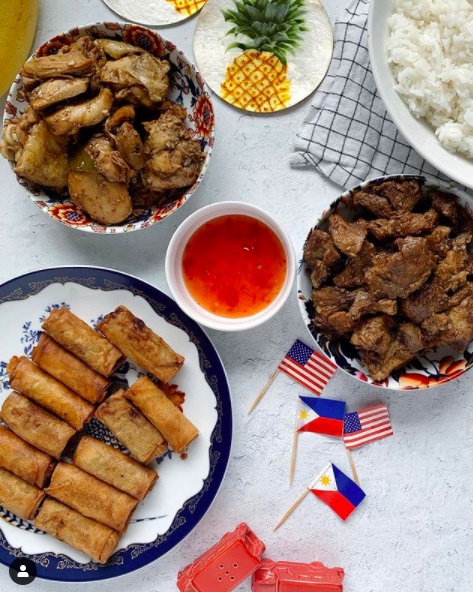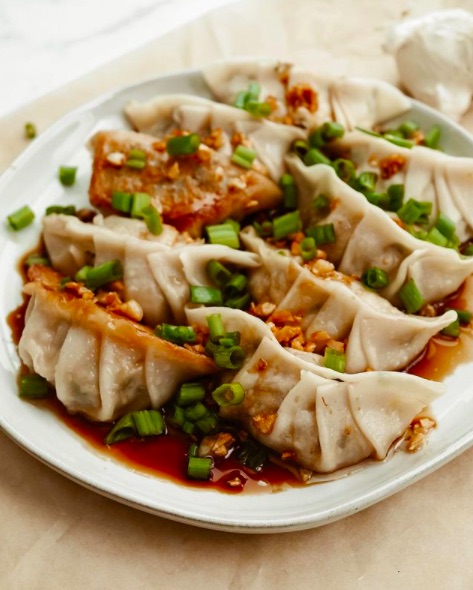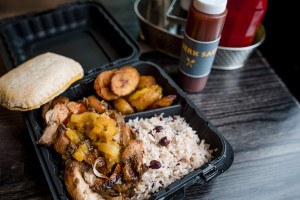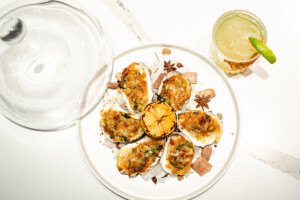Goodbye, Sloppy Styrofoam: Here’s How to Take Actually Stunning Photos of Takeout Food
We asked some Boston-area influencers for advice.

Photo via Getty
It was all so simple, once upon a time: You’d take a seat at a restaurant. A gorgeously plated meal would arrive. A few snapshots and a Clarendon filter later—ta-da! Your Instagram-perfect #foodporn was now ready for sharing, earning double-taps from followers and spreading free promotion for local restaurants that, bereft of big marketing budgets, need every bit of it.
But it’s not that easy during pandemic-times. In a dining era dominated by takeout, it’s hard to figure out how to shoot your snacks so they don’t look—well, sad. After all, while many chefs are certainly doing their best to approximate restaurant-worthy presentation for to-go meals, let’s face it: By the time the delivery driver ushers your order to your door, there’s a very good chance it’s slopped around quite a bit in its Styrofoam container (which, incidentally, is hardly a photogenic place setting to begin with). And have you ever tried to make food look mouthwatering when you’re eating it off your lap in your car? I have. It didn’t go well. You can tell from the marinara stains on my jeans.
If bemoaning the difficulties of Instagramming takeout food sounds like an insufferable First World Problem—well, fair enough. Bear in mind, though, that social media really has become an indispensable tool for restaurants trying to get the word out. Hence the rise of food-world influencers, the most of successful of whom score brand sponsorships and thousands of followers with every bite of their food and click of their camera.
Of course, most of us don’t have ambitions to become the next big Instagram star. But plenty of amateurs among us still love sharing our meals as a way to support our favorite restaurants. With that in mind, we asked a few of Boston’s biggest industry influencers for tips and tricks on how to actually get decent photos of takeout.

Filipino takeout from Foodega. / Photo courtesy of @confessionsofachocoholic
Put it on a plate.
First things first: Though pros might be able to attractively photograph takeout food in its natural habitat, that’s probably a bad idea for a novice. Ditch the cardboard containers that arrived via DoorDash and artistically arrange the food on a few of your own plates. Err on the side of smaller dishes (to make the portions look larger and more nom-worthy) and, if you can, use a few different shapes for visual interest. Opt for lighter colors like white or cream, or sandy stoneware, since they are less likely to compete with the food itself, says food blogger Bianca Garcia (@confessionsofachocoholic).
And for the love of god—wipe the edges. Nothing spoils a photo like an unnoticed gloop of dried-out sauce lingering like a cold sore on the lip of a plate. Did that sound gross? Well, imagine how it looks.
Turn your table into a tableau.
Once you’ve plated your items, it’s time to arrange them like a still-life painting—or at the very least, like a page ripped from Food & Wine. While your kitchen counter might work perfectly fine as a backdrop, don’t shy away from using a stunning tile floor or other, non-traditional dining surface that complements the cuisine. (No one needs to know that lovely “tablecloth” is really a bedsheet with a particularly cool pattern.)
Using different backdrops will lend variety to your Instagram’s home page, so if you’re planning to go whole-hog with this, you may even want to invest in dedicated surfaces, says Brittany DiCapua, who runs her own digital marketing biz, Eleven Seven Media, in addition to an Instagram account (@bostonfoodjournal) with over 46,000 followers.. She recommends white marble or cement squares from Replica Surfaces, for starters.
Otherwise, adds Garcia, simply invest in a few simple placemats to add pops of color, or fabric napkins that can be gently rumpled and laid among the plates. The suggestion of active eating can be good: Take a clean bite out of a pizza slice, for instance, or hire your spouse to be a hand-model wielding chopsticks. Finally, you might want to add a few other signs of personal life to the shot: Say, a favorite book, if you’re eating off your coffee table. Offer little glimpses of your real life to keep things from looking contrived.
Make it personal.
To that point, consider this: People have already seen plenty of photos of tacos on Instagram, but they haven’t seen how you are savoring them—say, while sitting on a pretty city stoop after snagging those tortillas from a food truck. “I think it’s a beautiful time right now for Instagram photography to step back and make it less about gorgeous plates, and more about the experience of doing takeout and supporting restaurants,” says Brian Samuels (@briansamuelsphotography), a professional food and beverage photographer who works regularly with some of Boston’s biggest restaurants (and has quite a following of his own).. “We don’t need to see the same beauty shot on account after account. It’s more compelling photography to give it your own personality.”
In other words, instead of always struggling to make your takeout food look perfect, try capturing the act of enjoying it (which is the point, after all). Capture yourself cuddling with a ramen bowl on the couch during a snow day, or cooking with a home-delivered meal kit during a date-night. It’s not (totally) self-involved; it conveys how restaurants continue to bring us comfort and joy, even at home. And besides, it can be a lot more interesting than yet another aerial image of a sushi roll.

Myers+Chang dumplings. / Photo courtesy of @bostonfoodjournal
Play it down the middle.
Speaking of those overhead shots—they’re a bit overused. While top-down photos can certainly be attractive, many foods, like burgers or subs, benefit from being sliced in half to show their gooey inner goodness, says Marnely Murray (@marnely_murray), a Martha’s Vineyard-based food blogger, sous chef, and social media manager. “Excess is what sells on Instagram,” Murray says. “With anything hand-held, like a burger, cut it in half and hold it up. Anything where you can see the cross-sections is a lot more attractive.”
Bring things back to life.
By the time you’re ready to eat, your food may have sat long enough to look a little limp. Do what you can to reinvigorate it: For instance, DiCapua might toss her mac ‘n’ cheese in the microwave for a few seconds, to achieve a gorgeously gooey shot of fork-pulled cheese. She’ll also use soy sauce from her fridge to freshen up dumplings, or toss freshly chopped basil atop a mound of pasta. Little tweaks can make a big visual difference.
Tell stories.
If you just can’t get a great shot for your Instagram home page, turn to the stories feature. Because they’re generally used for more frequent, casual shares (that are only visible for 24 hours), there’s not as much pressure to make things look perfect. Instead, you can promote the restaurant with a few quick snaps of unpacking the takeout, scarfing a bite, and maybe even sharing a 15-second review. Garcia takes things a step further: She organizes some of those stories into permanent highlight reels on her home page, categorizing them by restaurant or theme (such as “Food Delivery” or “Shop Local”). There they’ll live forever as a growing diary of your dining-in days—and soon enough, your dining-out again, too.


